|
|
|
|

Journal of International Relations and Development
Austrian Intra-firm Trade with Central and Eastern Europe
by Wilfried Altzinger
*
Introduction
Due to the opening-up of Central and Eastern European countries (CEECs) in 1989 and Austria’s integration into the EU in 1995, Austrian outward foreign direct investment (FDI) has increased strongly. In accordance with this development intra-firm trade has also increased considerably. It is generally assumed that multinational enterprises (MNEs) account for two-thirds to three-quarters of world exports, and that more than a third of world trade is between affiliated firms (UNCTAD 1999:232). Accordingly, it can be asserted that such a strong shift in FDI as the Austrian economy has experienced during the 1990s is also associated with considerable changes in intra-firm trade.
A graphic illustration will help explain the issue. Figure 1 shows four different kinds of intra-firm trade carried out by MNEs. Numbers from 1 to 4 label these different kinds of intra-firm trade. Throughout the paper, the region of reference is the home country of MNEs, namely Austria. Hence, exports and imports always mean exports from and imports to Austria. Figure 1 introduces some useful distinctions concerning FDI-related trade. Firstly, we distinguish two kinds of FDI, namely inward and outward FDI. Note that several foreign affiliates in Austria are involved in both inward and outward FDI. This is the case of foreign affiliates in Austria carrying out an investment in third countries (e.g. in CEECs). We call such affiliates (in Austria) "indirect" FDI. "Direct" FDI we use synonymously for (majority) Austrian-owned firms. Finally, we distinguish between total MNEs trade and intra-firm trade.
Intra-firm trade is expected to be well developed in particular within large MNEs with strong backward and forward linkages between parent firms and their affiliates throughout the different value-added stages of production. Like total trade, intra-firm trade depends on different motives of FDI. The expected impacts on trade differ depending on whether the FDI is resource-, market- or efficiency-oriented.
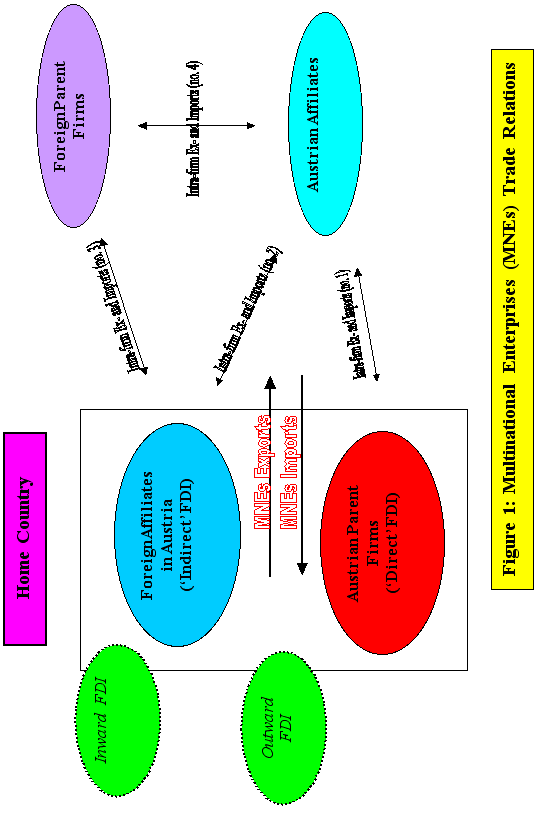
It is generally assumed that inward FDI helps boost total MNE exports. However, this kind of production might also be related to intra-firm imports if the foreign affiliate in Austria depends on intermediate products from foreign parent firms (no. 3). In contrast, outward FDI might have some negative impact on exports by replacing them through local production. Additionally, if outward FDI were carried out mainly for reasons of comparative cost advantages, both total imports and intra-firm imports might increase (no.1 and no. 2). Hence, Austrian outward FDI in CEECs is often associated with negative impacts on domestic trade. Due to public concern about this particular kind of FDI, our research is applied on Austrian intra-firm trade with CEECs (no.1 and no. 2) only. 1
The article is organised as follows. In the second section, we present some stylised facts on Austrian FDI and trade. After theoretical considerations of the implications of FDI on trade we formulate several hypotheses (in the third section) which are then tested (in the fourth section). The final section summarises the main findings and draws conclusions.
Stylised Facts on Austrian Foreign Direct Investment and Trade
The share of inward FDI and outward FDI in gross domestic product (GDP) measures the degree of a country’s globalisation. 2 This indicator shows that Austria’s outward FDI-GDP-ratio is far below the average of other small OECD (Organization for Economic Co-operation and Development) countries (UNCTAD 1999). In 1997 the average FDI-GDP-ratio for the European Union (EU) was almost three times higher than the Austrian ratio (18.6 percent compared to 6.7 percent). One of the main reasons for this low degree of internationalisation is Austria’s industry structure, especially the prevalence of small- and medium-sized enterprises (SMEs) (Bellak 1997; Clement and Bellak 2000).
However, Austria’s outward FDI-GDP-ratio has been increasing relatively quickly since the late 1980s (see Figure 2). For Austria, this period of "globalisation" has been characterised by two new and substantial economic developments: the pre-EU-accession period and the opening up of Eastern European economies. Both have enforced Austria’s international economic activities considerably. The outward FDI-GDP-ratio increased from 1.8 percent in 1989 to 6.7 percent in 1997. This development is mainly due to the opening up of CEECs. Starting from nearly zero in 1989, the FDI stock in CEECs accounted for 30.7 percent of Austrian total outward FDI in 1997. On the other hand, inward FDI has also grown considerably. During the 1990s, the "gap" between inward and outward FDI decreased by a large extent. However, in 1997 the relation between inward and outward FDI was still 1 to 1.32.
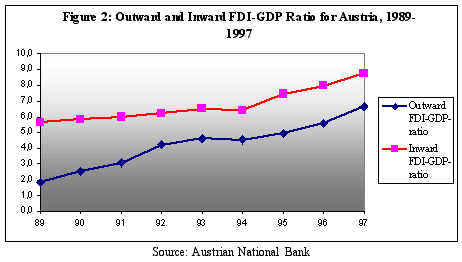
What can be said about the impact of outward FDI on trade? Figure 3 presents the development of MNEs’ exports and output of their foreign affiliates. Although both exports and foreign production increased significantly, we can see that foreign production rose more. Consequently, the ratio of exports to foreign production declined from 0.85 in 1989 to 0.55 in 1997. However, we should keep in mind that this development is the result of two effects: a growing number of firms which have carried out international investments and an increase of sales per affiliate. The number of parent firms that achieved these exports has increased from 552 in 1989 to 896 in 1997 while the number of affiliates grew from 895 (1989) to 2020 (1997). Accordingly, the amount of total sales per affiliate increased from ATS 171 million (1989) to ATS 215 million (1997). Accordingly, the total increase in foreign sales can mainly be attributed to the growing number of foreign affiliates.

Figure 4 shows the evolution of MNEs’ total exports and imports. Although MNEs’ trade balance was clearly positive throughout the 1989-1997 period, we can see that imports grew stronger than exports. Hence the ratio of exports to imports declined from 2.51 in 1989 to 1.39 in 1997. This ratio has remained relatively stable since 1991.

Summarising these stylised facts on Austrian trade and foreign production we are tempted to presume that, due to the strong growth of outward FDI, the trade balance was negatively affected. However, these results are quite heterogeneous for different industries and host countries and additionally might change over time. Therefore, we analyse these developments on a more disaggregated level. Before doing so, we develop several theoretical arguments and formulate hypotheses on the expected relationship between FDI and intra-firm trade.
Former Studies, Theoretical Considerations and Hypotheses
Until now there have only been a few studies that have analysed Austrian intra-firm trade. All of them conclude that Austrian intra-firm trade is relatively low by international standards. Neudorfer (1997) shows that Austrian intra-firm trade with CEECs increased particularly strongly during the early 1990s. Pfaffermayr (1998) finds some positive relationship between foreign production and intra-firm trade volumes. Further, he detects a positive relationship between foreign production and the intra-firm trade balance. His results indicate a complementary relationship between FDI and the intra-firm trade surplus.
The implications of outward FDI on intra-firm trade depend to a large extent on industry-, country- and firm-specific characteristics (Dunning 1993; Rojec 2000; Cantwell and Bellak 2000). We focus on the following distinctions:
One important topic in the analysis of outward FDI and intra-firm trade is the distinction of different kinds of FDI. Cantwell (1994), for instance, distinguishes between three kinds of international production: namely, the resource-based or export-platform production; the local market-oriented or import-substituting one; and the rationalised or internationally integrated type. 3 Resource-oriented FDI is mostly associated with strong intra-firm imports . Local market-oriented or export-substituting FDI has both trade-replacing and trade-creating effects. However, this trade is intra-firm trade only if the affiliate serves as a distribution outlet. Finally, Cantwell (1994) distinguishes an integrated type of international production which has the most complex relationship with intra-firm trade. This type of FDI can be classified further into vertical and horizontal integration. In the former, each affiliate contributes some stage of production to a common process co-ordinated between countries. Horizontal integration, by contrast, means that each affiliate contributes a particular product range that it exports to other countries in some wider geographical area. In particular, vertical integration of FDI is associated with intra-firm trade. The main purpose thereof is the separation of the value-added chain along country-specific "comparative advantages". Both up- and down-stream-integrated production increases intra-firm trade. Since an empirical distinction between these three kinds of FDI is almost impossible, we try to capture those effects by industry dummies.
The traditional line of argument presumes that CEECs should have comparative advantages in labour-intensive industries . In contrast, Landesmann (1997) argues that a growing share of EU trade with CEECs is of a "vertical" intra-industry type which stresses the point of strong price-quality gaps between imports and exports of the same industry. He concludes that the emphasis on more capital- and technology-intensive activities of FDI from the EU into some of the CEECs, notably Hungary and the Czech Republic, indicates that the long-term advantages of CEECs do not exclusively lie in low-tech, low skill production. To test these contrasting hypotheses, we use the capital intensity of affiliates as an explanatory variable for Austrian intra-firm imports.
A particular feature of Austrian economic activities in adjacent CEECs is their geographical proximity and close cultural and historical ties. Because of relatively low transport as well as transaction costs, we expect strong intra-firm trade with adjacent CEECs to Austria. In particular, this feature also enables SMEs to improve their international activities. One important aspect of FDI in general and for intra-firm trade in particular is the stage of development of the host country. As demonstrated by Lankes and Venables (1996), for CEECs a clear tendency from resource-oriented to market-oriented and towards an integrated type of FDI can be observed. Since the latter type of FDI is much more strongly associated with intra-firm trade we expect increasing intra-firm trade over time. Therefore, we use a time dummy which separates the whole period of observations into two sub-periods (1989 to 1992 and 1993 to 1997).
The impact of the mode of entry on the FDI trade relation is ambiguous. We distinguish between greenfield investments and mergers and acquisitions (M&A). From a theoretical point of view, this distinction might not be relevant since trade effects depend very much on the value of capabilities, skills and routines of existing local firms. Since the impacts of the mode of entry on intra-firm trade are manifold we hesitate to formulate a distinctive hypothesis concerning this issue.
Furthermore, different effects on trade are expected between "direct" and "indirect" FDI . A considerable number of MNEs investing in Central and East European Countries channel their foreign direct investment through an affiliate (e.g. a regional headquarter) set up in a third country (e.g. Austria). As explained above (see Figure 1), such FDIs are termed "indirect" FDI in order to distinguish them from those FDI set up by the parent (headquarter) directly. An "indirect" FDI is an outward FDI carried out by a foreign affiliate located in Austria. "Indirect" investments in CEECs are mainly set up by an Austrian headquarters due to its superior market knowledge. However, the main purpose is mostly not related to an intensification of their trade relations. In contrast, we would expect that trade relations are particularly strong between the affiliate in CEECs and the parent firm which is not located in Austria (intra-firm trade no. 4 in Figure 1). Accordingly, "indirect" FDI should not be exposed to intensive intra-firm imports. In contrast, since Austrian-owned FDI is highly integrated into this network, we expect stronger intra-firm imports for "direct" FDI.
Due to economies of scale at the firm level, we would expect that trade intensity increases with the size of parent firms . Accordingly, a variable controlling for the size of parent firms (measured by the number of parent employees) is introduced.
Finally, it should be mentioned that many papers explain intra-firm trade by research and development (R&D) intensity of parent firms and affiliates . The general notion of these studies is that internalisation advantages are particularly high in R&D intensive industries. Subsequent intra-firm trade should be relatively strong in R&D intensive industries. Since our data do not provide any information on R&D, we are not able to prove this relationship. 4
Data and Empirical Results
Data
To analyse the FDI-trade relationship of Austrian firms we use the FDI data set provided by the Austrian National Bank. This data set comprises the results of an annual survey for the 1989 to 1997 period, covering all firms with an investment of at least 1 ATS million. The data provide information on the amount of capital invested and its regional and sectoral structure as well as intra-firm trade and sales of the affiliates by region and sectors. Moreover, we have information on the size of the parent firms, mode of entry, year of foundation, ownership and capital-intensity of the affiliates.
Before starting the presentation of the empirical results, we should make a few general remarks about the data and point to some limitations of the data set used . Firstly, the data on trade flows may, as is often the case, be distorted by the under-invoicing (or over-invoicing) of intra-firm transactions. Due to country-specific tax regulations, such "transfer pricing" is common within MNEs. However, it is impossible to correct for this problem. Secondly, the problem of classification between sectors can considerably change the results. The OeNB data set is classified either by the host or home country. Since we are interested in particular in where Austrian firms invest and what implications their FDI have on trade, we use the sectoral classifications of the respective host countries. Thirdly, a firm is classified by the principal activity of that firm although it can be active in several sectors. This presents obvious problems with highly diversified MNEs. This problem can, however, be limited by using the sectoral classification of the affiliates. Fourthly, any empirical analysis needs to define what constitutes "a firm". Ideally, an estimate of the level of ownership should be included. Fortunately, the data provided by the OeNB allow us to distinguish between "majority Austrian-owned" ("direct FDI") and "majority non-Austrian owned" FDI ("indirect FDI").
Summarising these well-known remarks on the paucity of data, we can conclude that the specific OeNB data set of Austrian FDI has many of the usual shortcomings, but it has at least two advantages avoiding several common empirical limitations: the specific distinction of ownership and the specific distinction of the affiliates by the host country classification. However, the problem of "transfer pricing" remains.
Austrian Intra-firm Trade with CEECs
Regional and Sectoral Structure
Figure 5 shows the overall development of Austrian intra-firm trade with CEECs. As can be seen, both intra-firm exports and intra-firm imports have grown very strongly. 5 Throughout the period Austrian MNEs achieved an ever-growing intra-firm trade surplus. In 1997, this surplus was 5.5 ATS billion. By analysing regional and sectoral patterns we get a better insight into this overall development.
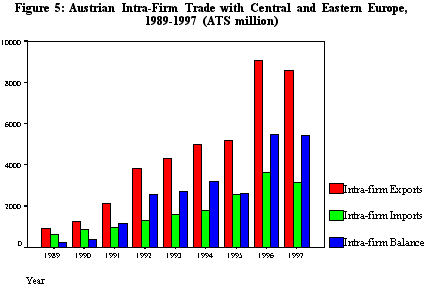
Figure 6 shows intra-firm export shares of total exports for different regions. In 1997 this share was 4.2 percent for total intra-firm exports, whilst for CEECs this share was 7.2 percent. In particular, Hungary (9.1 percent), the Czech Republic and the Slovak Republic 6 (13.0 percent) display high intra-firm export shares.
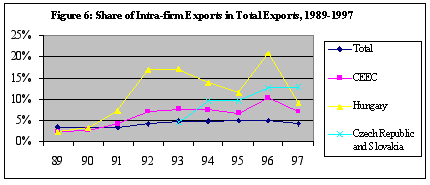
The same regional differences apply to intra-firm import shares (see Figure 7). In 1997 intra-firm imports accounted for 2.2 percent of total imports only. In contrast, this share was 4.8 percent on average for all CEECs, 7.3 percent for Hungary and 5.3 percent for the Czech and Slovak Republics. It can be seen for exports as well as for imports that these shares grew throughout the period 1989-1997 for all CEECs.
These figures show at least two features. Firstly, it is obvious that Austrian intra-firm trade is much more developed with its adjacent CEECs than its total intra-firm trade. This feature confirms the expectation that geographical proximity matters. Secondly, intra-firm export shares with CEECs are much higher than intra-firm import shares. Having in mind that Austria achieved large total trade surpluses with CEECs between 1989-1997, we conclude that trade imbalances of intra-firm trade are significantly stronger than those of total trade.

The sectoral patterns of Austrian intra-firm trade with CEECs provide some relatively interesting properties (see Figure 8). The first issue that appears is the particular situation of the trading sector. With ATS 4.4 billion in 1997 the trading sector accounts for 80 percent of total intra-firm surplus. This is the expected pattern of distribution-oriented FDI. However, we should account for the differences in the sectoral classification. Since this classification is organised along host country industries, the dominance of the trading sector is of no surprise. Some cross-sectoral classifications of home and host country industries have shown that in 1997 only 40 percent of total investment in the trading sector was carried out by the domestic trading sector . Austrian holding companies, finance and insurance and other manufacturing sectors invested the remaining 60 percent. In particular, such cross-investments from manufacturing to trade induces huge intra-firm surpluses. Accordingly, these results emphasise that many Austrian affiliates in CEECs are distribution-oriented outlets only. Since the trading sector is a specific kind of FDI and does not provide any further information on the separation of value-added stages of production the following parts of the analysis focus on manufacturing industries.
Figure 8: Sectoral Composition of Austrian Intra-Firm Trade with Central and Eastern Europe, 1997 (ATS million)
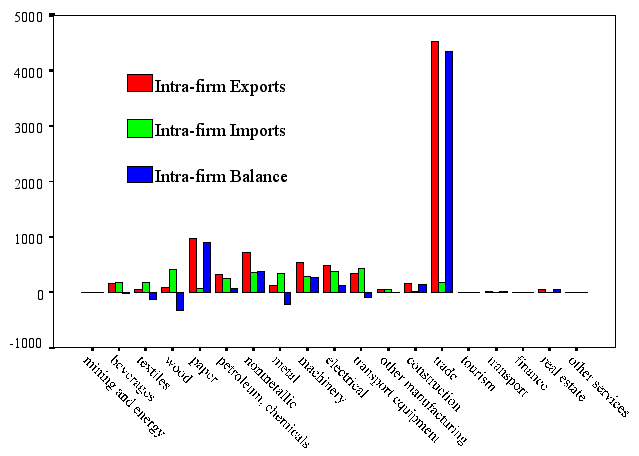
The Determinants of Intra-firm Imports from CEECs
For confidentiality reasons, all calculations presented and discussed until now were performed using aggregate data. For a smaller set of hypotheses we had the unique opportunity to test them with the use of firm level data. This section presents the results of this analysis.
As already mentioned, the question of "outsourcing" is mostly associated with growing imports from foreign affiliates. This is the reason why we focus on intra-firm imports. Since Austrian intra-firm trade with CEECs is in a relatively early stage of development we decided to run the regressions for the most recent year (1997) only. Since "outsourcing" takes place mainly in the manufacturing sector, we concentrate on the data for manufacturing. Based on the theoretical considerations in section 3, we specified a set of explanatory variables (see Table 1).
Because of our interest in the determinants of relative intra-firm imports we specified the dependent variable IFIM as the share of intra-firm imports by total sales of the affiliates. Independent variables were specified based on what was argued in the third section. Dnew FDI provides information about the year of foundation of the affiliate. This dummy is 1 if the affiliate was founded between 1993 and 1997. We expect that new FDI is more of an integrated type and therefore shows stronger intra-firm imports. Dindirect FDI indicates the ownership of investment. "Direct" FDI and "Indirect" FDI are used for "majority Austrian-owned" and "majority non-Austrian owned" investments, respectively. We expect that affiliates of "indirect" FDI export large parts of their output directly to the parent firm not located in Austria. Therefore, the coefficient for this dummy is expected to be negative. Furthermore, we have introduced a dummy for greenfield investment (Dgreenfield FDI ). As discussed above, the impact of different modes of entry on intra-firm imports is ambiguous. The coefficient for size of the parent firm is expected to be positive since larger firms should be better equipped to handle transactions spanning over national borders. If it is true that CEECs have comparative advantages in labour-intensive industries, the coefficient for capital intensity of the affiliates should be negative. However, if large parts of intra-firm trade are of an intra-industry type, the sign of the coefficient for capital intensity is ambiguous. Finally, four regional dummies and eleven dummies for industries were included in the analysis. Summarising these variables, the following equation will be estimated:

The regressions are undertaken by applying Ordinary Least Square estimation techniques. Since for a large number of observations the dependent variable is zero we specified two different regressions. Firstly, a regression was tested for all cases by introducing a dummy for cases with intra-firm imports larger than zero (DIntra-Firm Imports ). Secondly, the same regression was performed for cases with positive intra-firm imports only. Results are shown in Table 2. 7
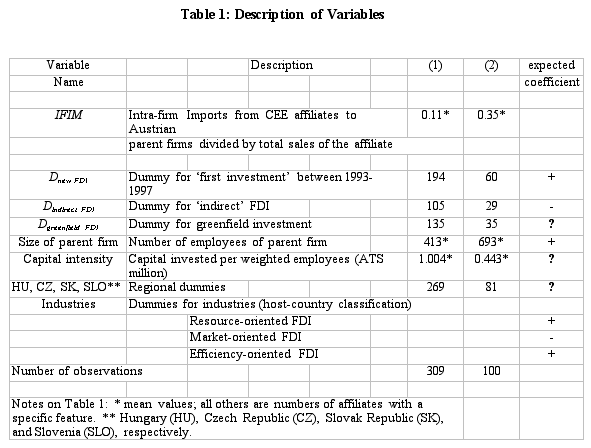
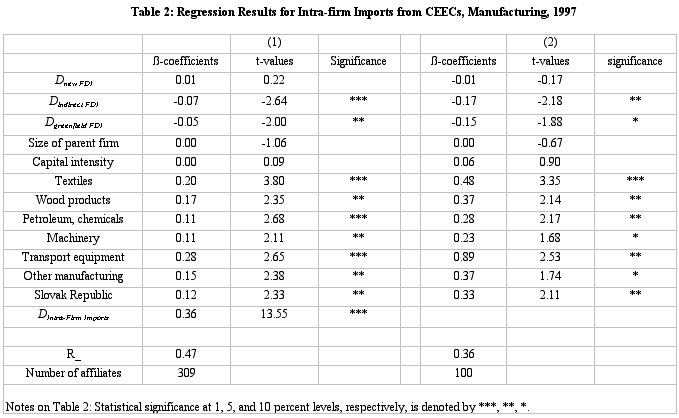
Both regressions provide surprisingly similar results. Since differences in significance are only minor, we will refer in the following to the results of equation (1) only which displays the results for all affiliates. The results provide several interesting features.
Firstly, the coefficient for "indirect" FDI is negative and significant. This result confirms that such Austrian parent firms are less involved in the separation of different value-added stages of production. It seems to be that such sub-affiliates perform most intra-firm trade directly with their foreign parent firms not located in Austria .
The dummy for greenfield investment is negative and significant. This type of FDI carries out significantly less intra-firm imports than M&A. As already mentioned, trade patterns of both greenfield investments and M&A depend strongly on the value of capabilities, skills and routines of the acquired affiliates. Accordingly, it seems that acquired foreign firms in CEECs fit better into the international division of labour of the Austrian parent firm than greenfield investments. Another interesting result, which is related to this issue, is the insignificance of the dummy variable for new investment. FDI, which was established in the earlier period of transformation (1989-1992), does not show lower intra-firm imports than FDI carried out more recently (1993-1997). Both coefficients indicate that Austrian parent firms were relatively successful in "picking up" their most favoured foreign affiliates in the early process of privatisation. These results are in line with the perception that Austria was relatively quick and successful in capturing market shares in CEECs due to their considerable "first mover advantages" like geographical proximity and close cultural and historical ties .
Contrary to expectations and former empirical studies (e.g. Zejan 1989), the size of parent firms does not explain any intra-firm imports. One explanation for this result might be the size of Austrian parent firms. As already mentioned, this FDI was carried out to a large extent by SMEs (Altzinger 2000).
Remarkably, the capital intensity of affiliates is of no significance. However, industry dummies might capture this variable. Most coefficients of industry dummies are as would be expected. First, in particular labour-intensive industries like textiles and wood products show significantly higher intra-firm imports. In both regressions these coefficients are strong and significant. Furthermore, petroleum and chemicals also show significant high intra-firm imports. These intra-firm imports can mainly be explained by deliveries of raw materials to their parent firms. In contrast to textiles and wood products, petroleum and chemicals are industries with high capital intensity. 8 Three more industries show strong intra-firm imports, namely machinery, transport equipment and other manufacturing industries. As can be seen from the aggregated data in Figure 8, these industries display relatively balanced intra-firm imports and intra-firm exports. Such patterns are expected in industries where forward- and backward-linkages are strongly developed. One other study for Austria has indicated that FDI in these sectors are particularly encouraged by low labour-costs (Altzinger 1998). Accordingly, we conclude that these sectors are well fragmented along different value added stages of production.
Finally, regional dummies do not indicate large differences of intra-firm trade between Hungary, Slovenia and the Czech Republic. Only the Slovak Republic shows somewhat higher intra-firm imports than the others. However, by interpreting these regional dummies we have to keep in mind that these are results for intra-firm trade with CEECs only. As was shown already (see Figure 6 and Figure 7), the main differences of intra-firm trade intensity can be observed between Austrian affiliates in CEECs and affiliates in other foreign (mainly EU) countries.
Concluding Remarks
During the 1990s Austrian outward FDI increased rapidly. This strong growth was due to Austrian integration into the European Union in 1995 and the opening-up of adjacent CEECs in 1989. In accordance with this development, FDI-related trade and in particular FDI-related intra-firm trade has increased strongly.
Since we are particularly interested in "outsourcing" of specific value-added stages of production, we focused in this paper on Austrian outward FDI-related intra-firm trade with CEECs. This intra-firm trade shows strong and growing trade surpluses over the 1989 to 1997 period. However, most of this surplus was achieved by the trading sector, which uses its foreign affiliates in CEECs mostly as distribution outlets. Therefore, we restricted the empirical analysis to intra-firm imports within manufacturing. The determinants of intra-firm imports were tested with data of each affiliate by regression analysis. Strong support was attained for the assumption that "indirect" FDI displays considerable lower intra-firm imports than "direct" FDI. This feature can be explained if we keep in mind that such investments were carried out via Austria only due to inherent "first-mover advantages". Whilst most activities of these sub-affiliates are exchanged between them and their headquarters which is not located within Austria, the Austrian unit was mainly involved as an organisational constituent (see Figure 1).
Contrary to widely held public perceptions, greenfield investments display significantly lower intra-firm imports than M&A. However, this result also emphasises theoretical reflections that the outcome depends mainly on the value of capabilities, skills and routines of the acquired firms. The observation that intra-firm imports do not differ between earlier investments (1989-1992) and later investments (1993-1997) confirms this conclusion. It might be an indication that due to "first-mover advantages" Austrian parent firms selected their specific favoured acquisitions right from the beginning.
Industry dummies show that labour-intensive industries like textiles and wood products have particularly high intra-firm imports. Furthermore, resource-oriented FDI like petroleum and chemicals also displays large intra-firm imports. Regional dummies indicate no differences between Hungary, the Czech Republic and Slovenia. Only the Slovak Republic shows significantly higher intra-firm imports. However, large differences for intra-firm trade can be detected between Austrian affiliates in CEECs and those in the EU. Affiliates in CEECs show considerable larger intra-firm imports as well as intra-firm exports than Austrian affiliates in EU countries.
Although these results provide new insights into Austrian intra-firm trade with CEECs, it should be noted that the impact of this increasing intra-firm trade on parent firms has not yet been scrutinised. 9 Future research should examine more thoroughly how these changes of intra-firm trade have affected the organisation of production of Austrian MNEs and, in particular, their performance and employment. Therefore, much empirical research on this subject is still to come.
June 2000
References
Aiginger, Karl, Rudolf Winter-Ebmer and Josef Zweimüller (1996) Eastern European Trade and the Austrian Labour Market. Weltwirtschaftliches Archiv 132(3), 476-500.
Altzinger, Wilfried (1998) "Austria’s Foreign Direct Investment in Central and Eastern Europe: ‘Supply Based’ or ‘Market Driven’?" Vienna: University of Economics and Business Administration, Department of Economics, Working Paper No. 57.
Altzinger, Wilfried (2000) "Umfang und Struktur der österreichischen Direktinvestitionen in den Reformstaaten seit 1989 -Zwischenbericht für das PREPARITY-Teilprojekt Nr. 5 des WIFO: "Transnationale Direktinvestitionen und Kooperation". Vienna: WIFO.
Altzinger, Wilfried and Christian Bellak (2001) The Impact of Direct and Indirect FDI in Eastern Europe on Austrian Trade and Employment. In Rajneesh Narula (ed.) Essays in Macroeconomics and Trade - Festschrift for Peter Gray, forthcoming.
Altzinger, Wilfried and Richard Winklhofer (1998) General Patterns of Austrian FDI in Central and Eastern Europe and a Case Study. Journal of International Relations and Development 1(1/2), 65-83.
Bonturi, Marcos and Kiichiro Fukasaku (1993) Globalisation and Intra-Firm Trade: An Empirical Note. OECD Economic Studies 0(20), 145-159.
Braunerhjelm, Pontus (1998) Organization of the Firm, Foreign Production and Trade. In Pontus Braunerhjelm and Karol Ekholm (eds.) The Geography of Multinationals, 77-97. Boston, Dordrecht, London: Luwer Academic Publishers.
Breuss, Fritz (1998) Benchmarks für den österreichischen Export. WIFO-Monatsberichte, 71(2), 91-106.
Cantwell, John (1994) The Relationship between International Trade and International Production. In David Greenway and L. Alan Winters (eds.) Surveys in International Trade,303-328, Oxford: Blackwell.
Cantwell, John and Christian Bellak (2000) The Impact of Foreign Direct Investment on International Trade. Journal of International Relations and Development 3(2), 120-127
Casson, Mark and Robert D. Pearce (1993) Intra-Firm Trade and the Developing Countries. In Peter Gray (ed) Transnational Corporations and International Trade and Payments, 99-126. London and New York: United Nations.
Clement, Werner and Christian Bellak (2000) Die Nettoposition der Direktinvestitionen Österreichs. In Bundesministerium für Wirtschaft und Arbeit, Österreichs Aussenwirtschaft, 180-204. Vienna: Bundesministerium für Wirtschaft und Arbeit.
Dunning, John (1993) Multinational Enterprises and the Global Economy. Harlow: Addison-Wesley.
Gray, Peter, H. (1993) The Role of Transnational Corporations in International Trade. In Peter H. Gray (ed.) Transnational Corporations and International Trade and Payments, 1-18. London and New York: United Nations Library on Transnational Corporations.
Lankes, Peter H. and Anthony J. Venables (1996) FDI in Economic Transition: The Changing Pattern of Investment. Economics of Transition 4(2), 331-347.
Markusen, James R. (1995) The Boundaries of Multinational Enterprises and the Theory of International Trade. The Journal of Economic Perspectives 9(2), 169-189.
Neudorfer, Peter (1997) The Opening of Central and Eastern Europe: The Case of Austrian Foreign Direct Investment. Focus on Transition 1(2), 52-68.
OeNB (1999) Direktinvestitionen Österreichs - Ergebnisse der Befragung 1997 und Entwicklung ausgewählter Indikatoren. Berichte und Studien 4, 56-68.
Pfaffermayr, Michael (1998) Die ‘stylized facts’ der Globalisierung aus makro- und mikroökonomischer Sicht. In Kammer für Arbeiter und Angestellte für Wien Fusionen und Übernahmen 1997, 19-43. Vienna: Manz.
Rojec, Matija (2000) Subsidiary Exports: A Conceptual Framework and Empirical Evidence. Journal of International Relations and Development 3(2), 128-152.
Siddharthan, Natteri S. and Nagesh Kumar (1990) The Determinants of Inter-Industry Variations in the Proportion of Intra-Firm Trade: The Behaviour of US Multinationals. Weltwirtschaftliches Archiv 126(3), 581-591.
UNCTAD (1999) World Investment Report 1999. New York, Geneva: UNCTAD.
Zejan, Mario C. (1989) Intra-Firm Trade and Swedish Multinationals. Weltwirtschaftliches Archiv 125(4), 814-833
Endnotes
Note *: Wilfried Altzinger is Associate Professor at the Vienna University of Economics.
The author gratefully acknowledges the provision of detailed data by Rene Dell’mour (Austrian National Bank) and thanks the anonymous referees, as well as Christian Bellak, Helmut Hofer, Michael Paffermayr and Chrilly Donninger for insightful comments on an earlier draft. The author also benefited from useful suggestions made by participants of the Annual Meeting of the Austrian Economic Association at Vienna in May 2000. Also, following the suggestion of the referee, the title of the article was changed. The usual disclaimer applies.Back
Note 1: Finally, an Austrian affiliate of an indirect FDI may trade with its headquarters (which is located outside Austria) directly (intra-firm trade no. 4). Unfortunately, we do not have any data on this intra-firm trade. Back
Note 2: Since this measure compares stocks (FDI) and flows (GDP), it is criticised by many authors (e.g. Bellak 1998:247). Such a comparison of stock and flow data is only useful if a constant capital-output ratio in the home economy can be assumed. Although we accept this criticism, we have to adhere to this measure since other data are not available. Back
Note 3: This type of FDI is sometimes called efficiency-oriented FDI (Lankes and Venables 1996). Back
Note 4: However, we have to note that most of these studies are restricted to IFT between industrialised nations where approximately 80 percent of total FDI flows occur. As Markusen (1995) has shown, this FDI and its associated intra-firm trade is important in particular in industries in which intangible, firm-specific assets and high levels of R&D are important. However, for FDI between developed and developing nations R&D might not be of such importance. Back
Note 5: The jump of intra-firm exports from 1995 to 1996 results mainly from one big intra-firm transaction in the electronics sector in Hungary. However, this was an exceptionally huge transaction which did not reappear in 1997. Therefore, we should use 1997 as a year of reference only. Back
Note 6: For these calculations the data could not be disaggregated for the Czech and Slovak Republics. Back
Note 7: Note only significant variables are shown. Back
Note 8: The insignificance of the explanatory variable "capital intensity" might be explained by this mixture of industries with high and low capital intensity. Back
Note 9: Such empirical research could be carried out using longitudinal data only. Back